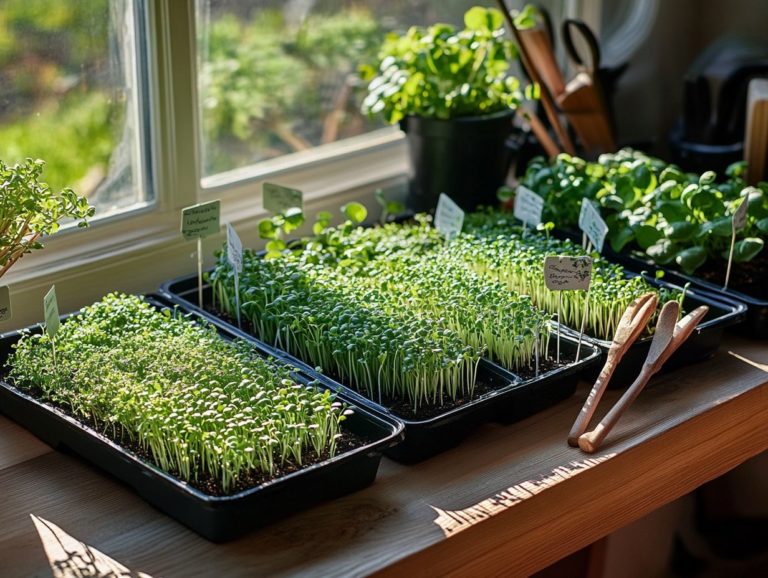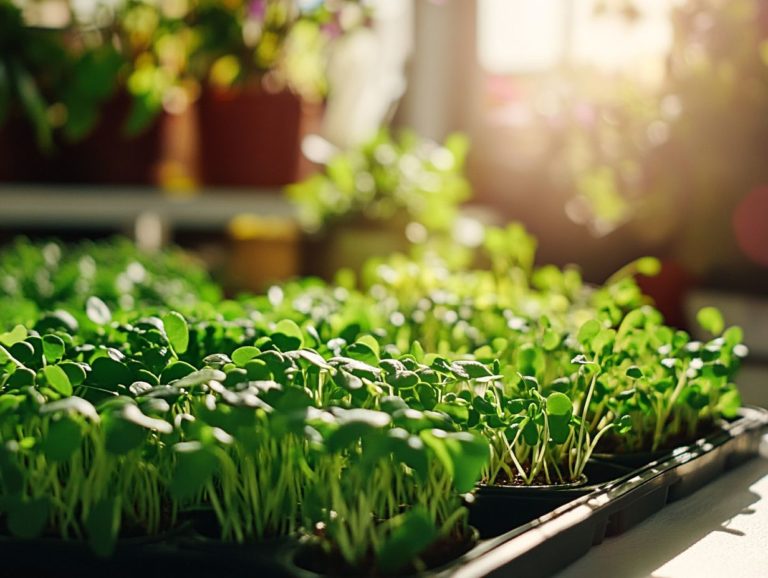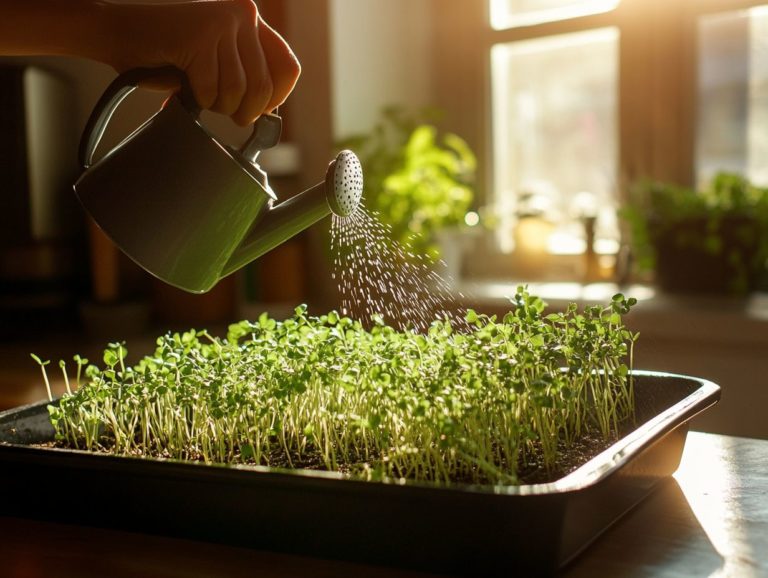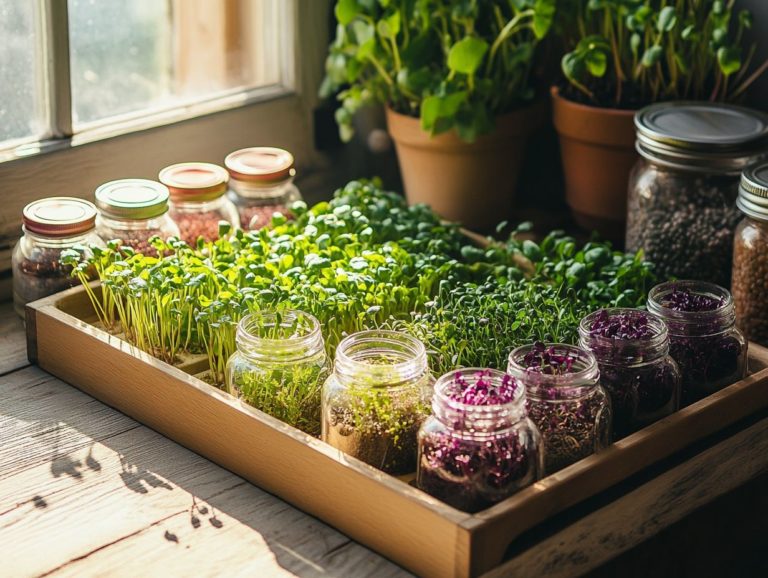How to Rotate Crops for Microgreens
Crop rotation transcends mere gardening technique; it serves as a powerful strategy to elevate the health of your microgreens significantly.
By alternating various crops, you not only enhance soil health and nutrient balance but also cultivate a thriving ecosystem that effectively reduces pests and diseases.
This guide will navigate you through selecting compatible crops, planning effective rotations, and sidestepping common pitfalls. It will also underscore the long-term benefits of this sustainable farming practice.
Immerse yourself in this journey to uncover how to maximize your microgreen yields and foster a healthier growing environment!
Contents
Key Takeaways:

- Rotate crops for microgreens to improve soil health and maintain nutrient balance while ensuring high yield.
- Choose compatible and complementary crops for rotation to optimize growth and yield.
- Manage soil and pests properly to avoid common mistakes and enjoy long-term sustainable farming benefits.
The Benefits of Crop Rotation for Microgreens
Crop rotation for microgreens is a smart gardening method that provides many benefits for urban gardeners aiming to elevate their yield and nutritional health.
By strategically alternating the types of crops in a designated area think basil, broccoli, and radish you can enhance soil health, minimize pest issues, and optimize the growing medium.
This approach leads to not only more robust seedlings but also quicker harvest times, allowing you to enjoy the fruits of your labor sooner.
Improving Soil Health and Nutrient Balance
Improving soil health and nutrient balance is essential for your success in cultivating microgreens, especially if you’re an urban gardener.
By implementing crop rotation, you allow the soil to recover, replenishing vital nutrients that can become depleted when you grow the same crops repeatedly.
For instance, incorporating legumes into your rotation is crucial for fixing nitrogen levels, significantly enhancing the fertility of your soil.
Embracing a diverse range of crops not only enriches the diet you can offer through your urban garden but also supports a more resilient ecosystem overall.
When you include various plants in your indoor edible garden, you naturally encourage beneficial microorganisms and worms, fostering a complex yet harmonious soil structure.
This diversity results in healthier, more nutrient-rich organic greens, and quick harvest options, giving you the power to provide delicious and sustainable produce to your community.
Choosing the Right Crops for Rotation
Selecting the right crops for rotation is essential for urban gardeners aiming to elevate both the yield and health benefits of their microgreens.
By choosing compatible crops like basil, collard greens, and rocket/arugula, you can profoundly impact the overall success of your growing cycle, enhancing flavors and textures.
This selection boosts productivity and creates deliciously diverse greens!
Compatible and Complementary Crops
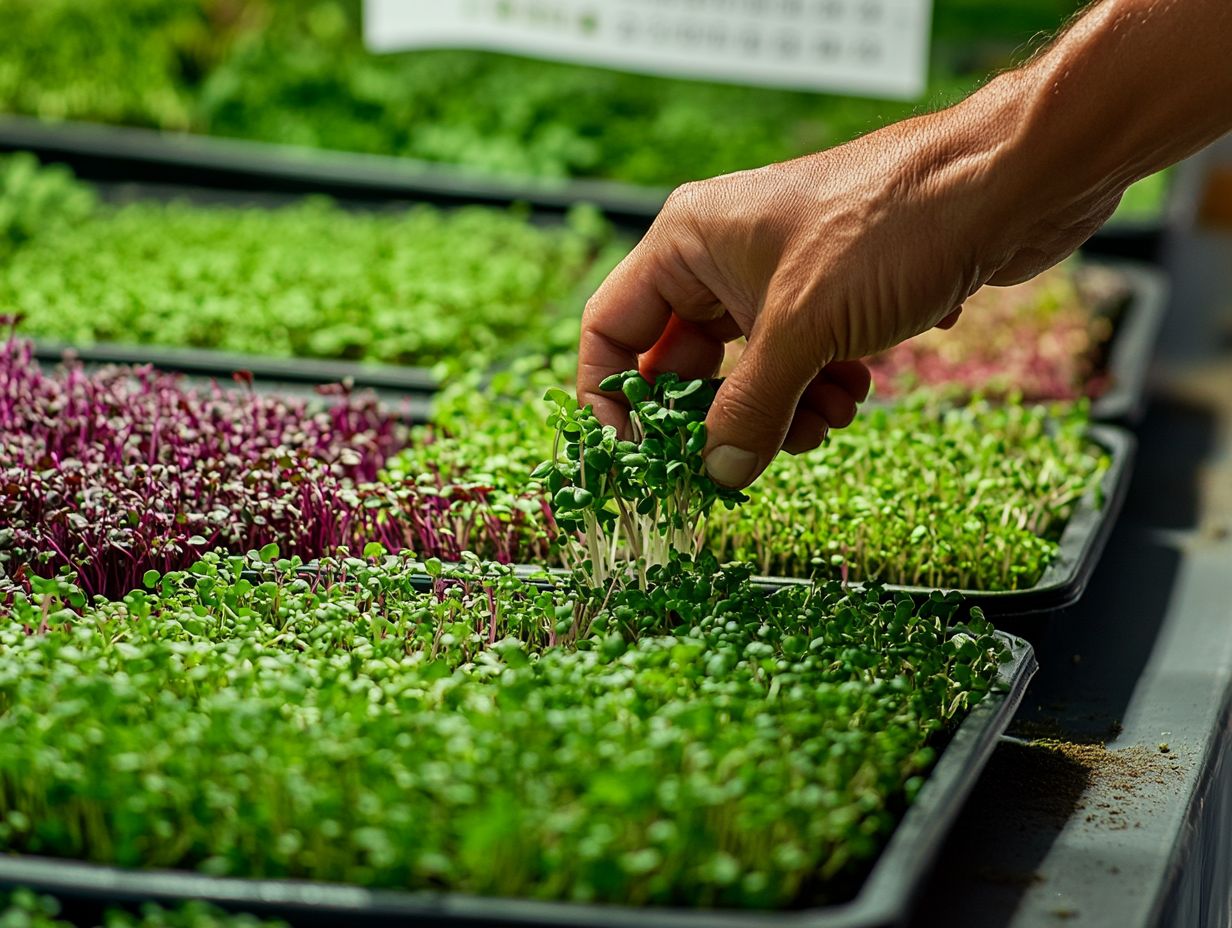
Understanding compatible and complementary crops is fundamental for maximizing the benefits of crop rotation in your microgreens cultivation.
By pairing crops like peas with radishes or spinach with parsley, you can enhance plant development and boost overall yields.
This practice also supports seed germination and contributes to quick-to-grow varieties.
This thoughtful approach optimizes your use of space and fosters beneficial interactions between plants.
For example, peas, as legumes, fix nitrogen in the soil, providing a nutrient boost for their neighbors like radishes. On the flip side, radishes can deter pests that typically plague crops, creating a natural pest management system.
Embracing crop diversity in your intercropping strategy offers significant advantages, such as varied flavors and improved resilience against diseases, enhancing both nutrition and taste.
By cultivating a diverse range of microgreens, you unlock a delightful palette of flavors while promoting healthier soil and robust plant ecosystems!
Start your crop rotation today and watch your microgreens thrive!
How to Rotate Crops for Optimal Growth
To achieve optimal growth in microgreens, you must follow a clear plan for crop rotation that involves careful planning and precise scheduling.
This method not only maximizes your yield but also enriches the health benefits linked to consuming a diverse array of organic greens.
Planning and Scheduling Crop Rotation
Planning and scheduling crop rotation are essential for maximizing the growth potential of microgreens in your urban garden. By strategically timing your planting and harvesting, you can ensure a steady supply of nutrients and flavors.
Using tools like digital calendars and growth cycle charts can help you stay organized. These resources allow you to meticulously track planting dates and harvest windows, helping you visualize the progression of different microgreens. For detailed instructions, refer to our step-by-step guide to sowing microgreens.
Adapting your schedules in response to environmental factors like light conditions, temperature, and humidity plays a crucial role in the health and yield of your crops. By consistently monitoring these elements, you can make informed adjustments, ultimately maximizing both the quality and quantity of your produce.
Common Mistakes to Avoid
Avoiding common mistakes in crop rotation is essential for your success as an urban gardener aspiring to cultivate vibrant microgreens and optimize your harvest. Failing to manage your soil effectively and neglecting pest control can lead to reduced yields and compromised nutritional quality.
Properly Managing Soil and Pest Control

Properly managing soil and pest control is essential for your success in crop rotation when cultivating microgreens. By employing effective practices, you protect your crops and ensure that nutrients remain available in the soil for future plantings.
As an urban gardener, you can greatly enhance your efforts by regularly testing soil pH levels. This simple step optimizes nutrient availability, ensuring that vital elements like nitrogen and phosphorus are accessible for robust growth, contributing to the thriving home gardening movement.
Incorporating organic amendments such as compost or well-rotted manure can significantly enrich your soil s fertility without worrying about chemical residues.
Implementing integrated pest management strategies a method that combines different strategies to manage pests effectively allows you to adopt a balanced approach to pest control. This could involve introducing beneficial insects or using natural repellents, which helps maintain the health benefits of your microgreens while also protecting the environment and supporting plant development.
These techniques not only cultivate a sustainable gardening practice but also contribute to the vitality of urban ecosystems.
Long-Term Benefits of Crop Rotation
The long-term rewards of crop rotation go beyond just immediate yields; they play a crucial role in fostering sustainable farming practices, especially in cultivating microgreens and sprouts.
By adopting this technique, you ll cultivate healthier soil, boost pest resistance, and enhance biodiversity. Each of these factors contributes to improved nutritional health for your crops while also boosting yields for leafy crops in your urban gardening efforts.
Start planning your crop rotation today to enjoy healthier veggies and a thriving garden!
Sustainable Farming and Increased Yields
Eco-friendly farming methods, like crop rotation, are essential for boosting yields in your microgreens cultivation while ensuring the long-term vitality of urban gardening ecosystems. By adopting these methods, you can grow a diverse array of organic greens that not only taste superior but also deliver enhanced health benefits.
Implementing crop rotation helps prevent soil depletion and pest infestations. This leads to healthier and more robust plant development. For example, a community garden initiative in Detroit has successfully used crop rotation to enhance its harvest of kale and spinach, significantly improving both the quantity and quality of their produce. Additionally, employing proper watering techniques for thriving microgreens can further support healthy plant growth.
This approach diversifies nutrient replenishment, allowing you to enjoy the fruits of a thriving ecosystem. These real-world examples highlight how sustainable techniques enrich urban environments and provide a meaningful boost to food security and community resilience.
Frequently Asked Questions
What is crop rotation for microgreens?
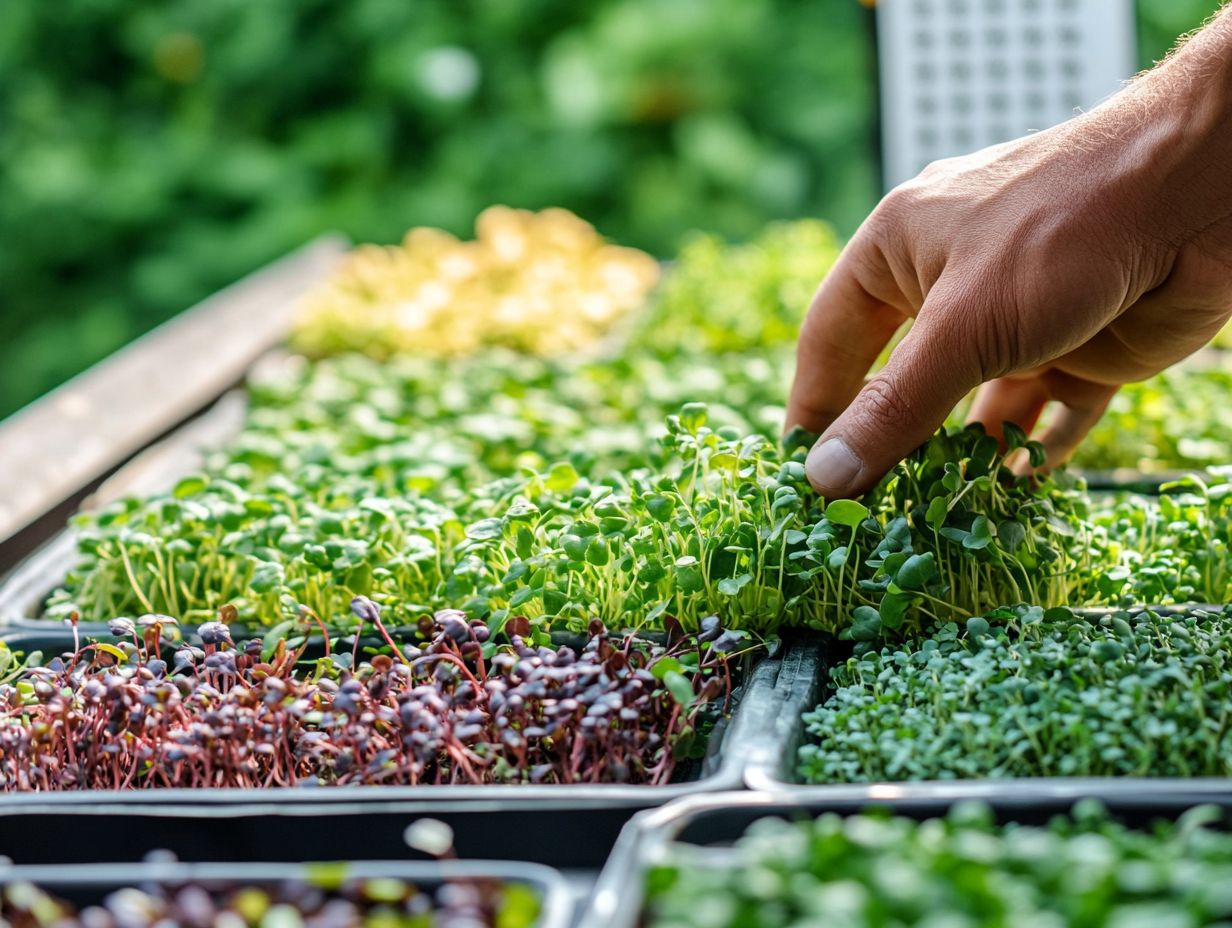
Crop rotation is the practice of growing different types of crops, including sprouts and leafy crops, in a specific area over multiple growing seasons. This improves soil health and reduces plant diseases.
Why is it important to rotate crops for microgreens?
Rotating crops for microgreens is vital for maintaining soil fertility, balancing nutrients, and preventing the buildup of pests and diseases that can affect growth and quality.
How do I rotate crops for microgreens?
To rotate crops for microgreens, alternate the type of microgreens you plant in a specific area each growing season. For instance, if you grew radish microgreens this season, plant a different type in that area next season.
What are the benefits of crop rotation for microgreens?
Crop rotation for microgreens helps improve soil structure, conserve nutrients, promote healthy root growth, and reduce the need for pesticides or fertilizers.
How often should I rotate crops for microgreens?
To keep your microgreens thriving, rotate them every 1 to 2 growing seasons. This helps maintain soil health and prevents pest and disease buildup. Proper seed preparation is also crucial during this process.
Are there any specific crop rotation plans for microgreens?
Yes, there are several crop rotation plans for microgreens. One common plan is the 3-year rotation, where the same type of crop is not planted in the same area for three consecutive years. Utilizing high mowing organic seeds from suppliers like Green Harvest can further optimize your crop rotation strategy.
Start your microgreens journey today and enjoy the delicious benefits of sustainable gardening!


